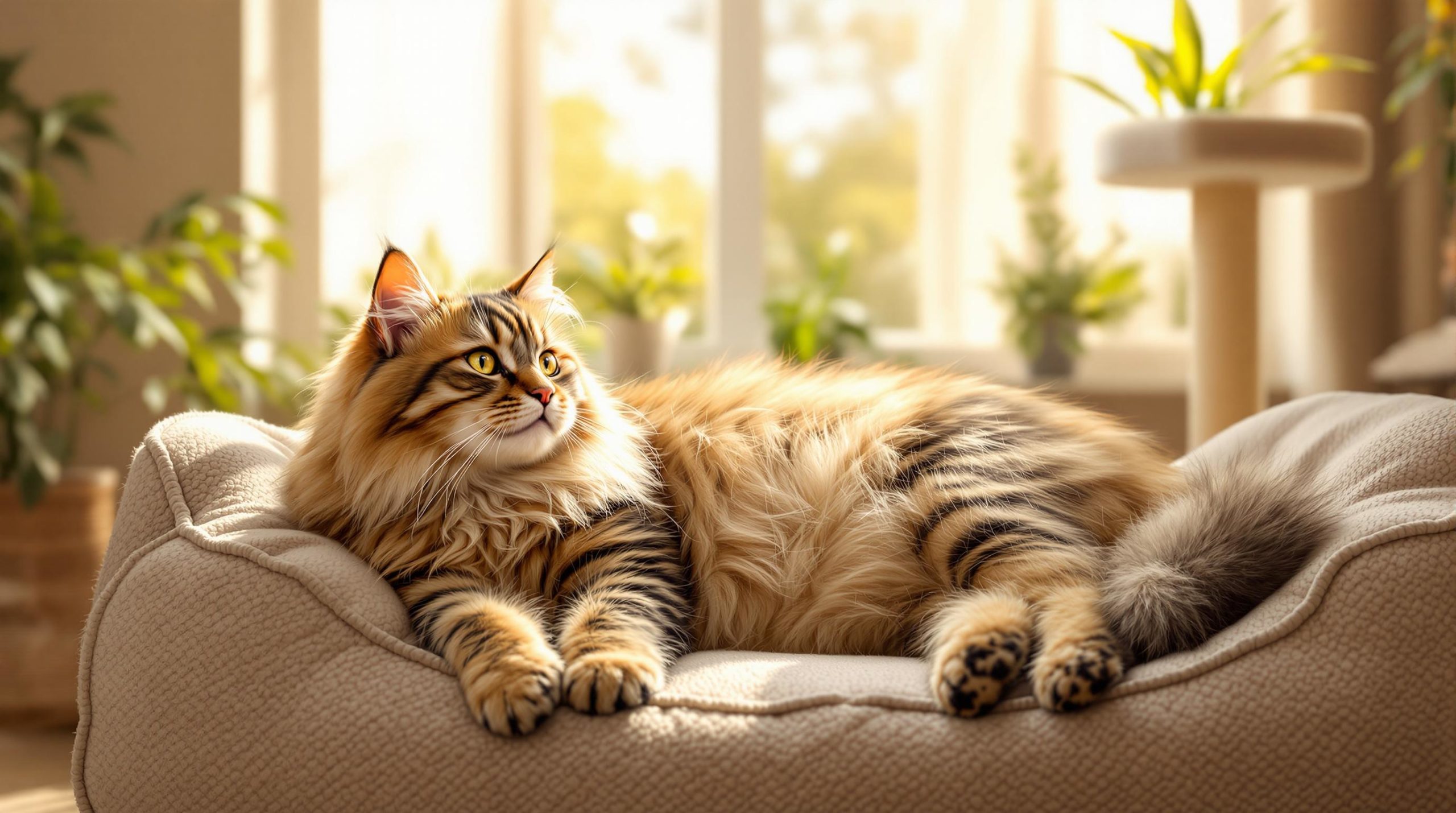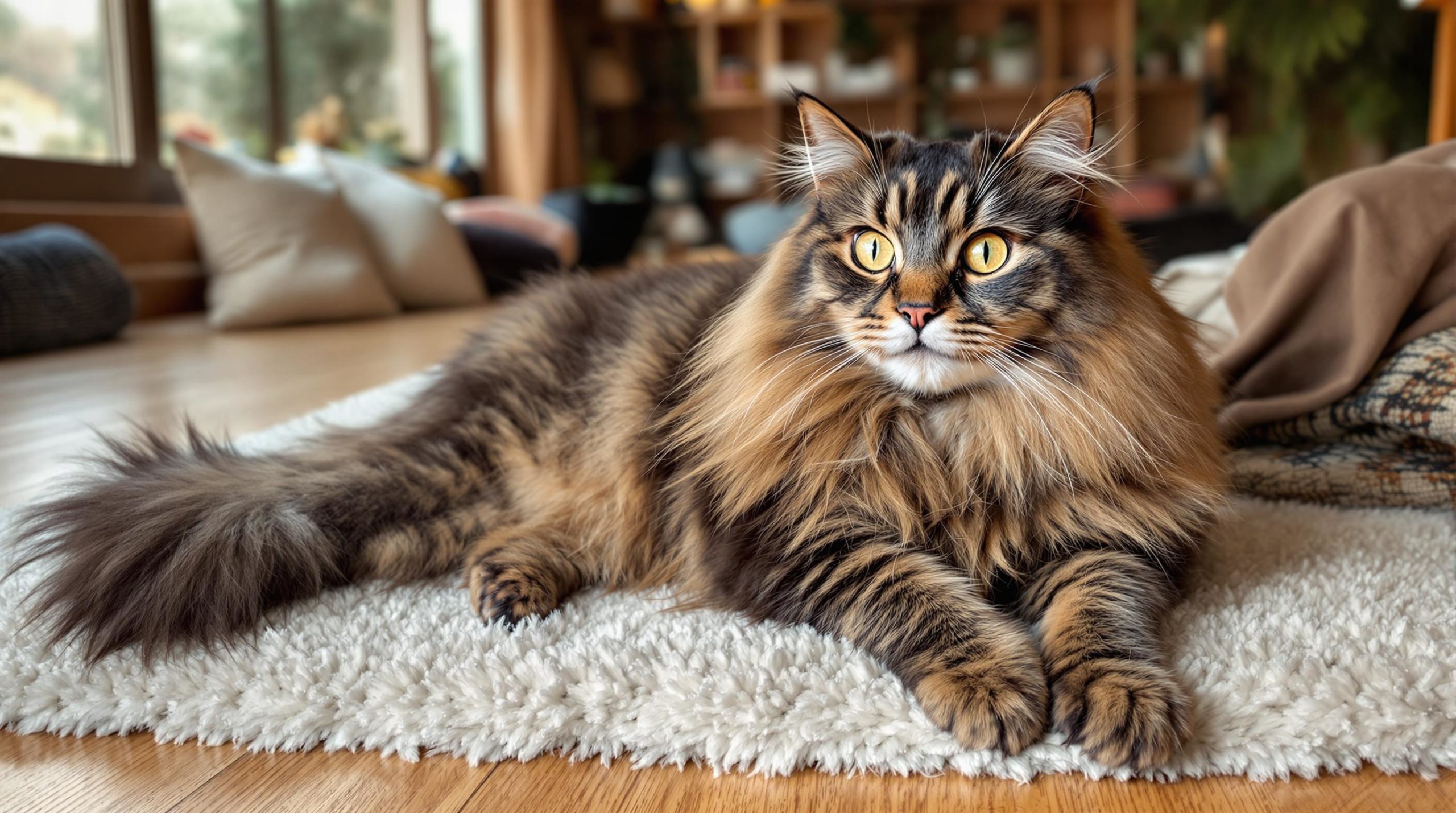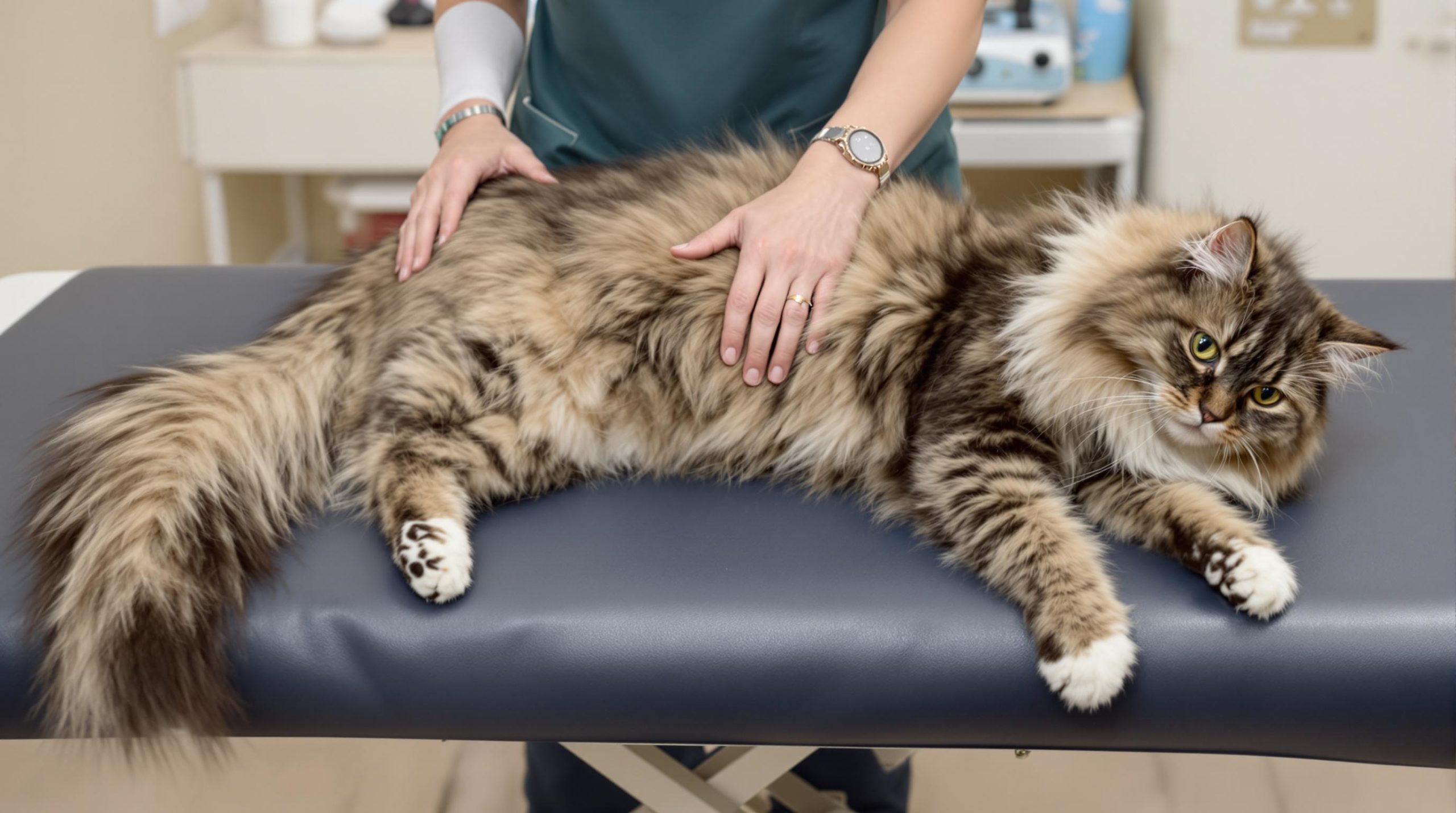What to know about caring for your fat Maine Coon

The Maine Coon cat stands out as a magnificent and large breed, well-loved for its gentle personality and impressive size. Caring for a Maine Coon that carries some extra weight requires informed attention to their unique physical and nutritional needs. Their size alone often leads owners to misunderstand whether their furry companion is just large or overweight, a distinction that can significantly affect feline health and quality of life.
While Maine Coons have that signature big-boned appearance, excessive weight can put them at risk for several health problems, from joint discomfort to serious metabolic conditions. Balancing proper nutrition, exercise, and regular veterinary care can ensure these stately pets maintain their vitality throughout their lives. This article explores the essentials of looking after your fat Maine Coon, giving insights into growth patterns, weight management, dietary habits, enrichment, and medical monitoring.
Understanding the difference between natural bulk and actual obesity is crucial to tailor pet care strategies effectively. Owners armed with knowledge of feline health and breed-specific characteristics can better support their beloved cats’ well-being. Dive into this comprehensive guide, which also features valuable resources on grooming tools, cat toys, pet accessories, and optimized feeding practices aimed at keeping your heavy Maine Coon happy and healthy.

Recognizing Healthy Size Versus Overweight in Maine Coon Cats
Maine Coons are renowned for their large stature, but discerning a healthy weight from obesity can be tricky due to their thick fur and natural body shape. Understanding the breed’s growth chart and body condition scoring can provide clarity, helping owners monitor their cats more effectively.
Maintaining an accurate assessment of your Maine Coon’s physique includes several diagnostic steps:
- Body Condition Score (BCS): This scale ranges from 1 (emaciated) to 9 (obese), with an ideal score around 4 or 5 for Maine Coons. A healthy cat exhibits a proportional waist and a firm muscle tone beneath its coat.
- Rib and Spine Palpation: Through gentle touch, owners should be able to feel the ribs and spine without excessive pressure. Difficulty detecting these features often indicates excess fat accumulation.
- Visual Inspection: Look for a tucked abdomen when viewed from the side and a visible waistline from above. A saggy or rounded belly suggests additional fat storage.
- Activity Monitoring: Healthy Maine Coons are playful and nimble. Changes in mobility such as reluctance to jump may point to weight-related issues.
- Regular Weigh-ins: Measuring weight weekly using a pet scale provides concrete data. Male Maine Coons typically range from 13 to 18 pounds, females 8 to 12.
These steps are vital to establishing realistic expectations and care routines. The Maine Coon growth chart is a useful tool for understanding normal weight progression during kittenhood through adulthood. Because this breed matures slowly—over up to four years—weight fluctuations during growth spurts at around 32 and 50 weeks are normal but should be monitored carefully.
Owners often confuse the breed’s natural saggy belly pouch, also called the primordial pouch, as fat. This pouch is a genetically bestowed feature that provides skin flexibility for running and hunting. However, if this area becomes rounded or bulges outward, obesity is a probable concern requiring a health-focused intervention.
Observing your Maine Coon’s behavioral cues during play and rest can provide subtle hints about their weight. Lower energy levels, lethargy, or breathing difficulty during routine activity are red flags. Since obesity can exacerbate health issues like arthritis and diabetes, early recognition is key for a long, quality life.
| Weight Indicator | Healthy Range (lbs) | Potential Concern |
|---|---|---|
| Male Maine Coon | 13 – 18 | Over 20 lbs might indicate excess fat |
| Female Maine Coon | 8 – 12 | Above 15 lbs requires check-up |
| Body Condition Score | Ideal: 4-5 | Scores above 6 suggest obesity |
| Rib Palpation | Ribs easily felt without pressure | Hard to feel ribs often indicates overweight |
Adjusting Care Considering Natural Breed Variations
The polydactyl trait prevalent in some Maine Coons adds to their uniqueness but does not influence weight directly. Understanding such breed-specific factors helps refine monitoring practices. Additionally, contrasting Maine Coons with other large breeds like the Norwegian Forest cat reveals that while sizeable, Maine Coons typically have more muscular builds and denser bone structures, which influence how weight is distributed.
Owners are encouraged to explore resources on proper grooming techniques that contribute to better visibility of body contours, assisting in weight assessment. Well-maintained fur prevents matting that could disguise weight gain issues.
Key Factors Influencing Weight and Health in Fat Maine Coons
The size and weight of a Maine Coon hinge on several intertwined factors that range from genetic predispositions to lifestyle choices. Grasping these variables empowers owners to manage their cats’ health proactively.
Genetics and Growth Potential
Genetics lay the foundational blueprint—in particular, genetic lineage dictates the skeletal frame and muscular potential. Some bloodlines are predisposed to larger, heavier cats, while others remain more moderate in size. Despite genetics, environmental influences like feeding and exercise can alter the outcome significantly.
Dietary Habits and Cat Food Selection
Choosing cat food apt for a Maine Coon’s unique metabolism is paramount. High-quality protein stands as the cornerstone of their diet, with lean sources such as chicken, turkey, or fish recommended. Excessive fat or carbohydrate content often contributes to unwanted calorie surplus and fat storage. Portion control is equally important, especially since Maine Coons are known for their hearty appetites.
Recent studies emphasize a balanced diet featuring:
- High animal-based protein (minimum 70%) aligned with their carnivorous nature
- Moderate levels of fats (20-30%) with emphasis on omega-3 and omega-6 fatty acids for coat and joint health
- Minimal carbohydrates to avoid rapid weight gain and maintain feline digestive health
- Fiber sources such as pumpkin or beet pulp to support digestion and reduce overfeeding tendencies
Employing feeding strategies like scheduled meals, measured portions, and the use of puzzle feeders encourages controlled intake and mental enrichment simultaneously.
Exercise and Enrichment for Weight Control
Physical inactivity directly contributes to fat accumulation and loss of muscle tone. Maine Coons are naturally active cats craving stimulation through play and exploration. Integrating daily sessions of interactive cat toys—using feather wands, laser pointers, or motorized mice—mimics hunting behavior that burns calories and engages their intelligent minds.
Cat trees and scratching posts aligned with their size enable climbing and stretching, supporting joint health and muscle maintenance. Outdoor escapes through secured catios cater to their curiosity and exercise needs while providing mental enrichment.
The following list highlights desirable activity types for overweight Maine Coons:
- Interactive play for at least 20-30 minutes daily
- Encouraging climbing on sturdy cat furniture
- Utilizing puzzle feeders to combine feeding with physical effort
- Leash training or safe outdoor time to diversify stimulation
| Factor | Impact | Management Tips |
|---|---|---|
| Genetics | Sets growth ceiling and body structure | Know lineage, monitor growth regularity |
| Diet | Major influence on fat accumulation | Feed balanced, measured meals; high protein, low carbs |
| Exercise | Burns calories; maintains muscle tone | Provide daily play and climbing opportunities |
| Age and Metabolism | Metabolism slows with age, risking weight gain | Adjust diet and increase gentle activity |
| Neutering Status | May reduce activity and increase appetite | Monitor food intake and increase exercise |
Health Risks and Complications Linked to Obesity in Maine Coons
Understanding the consequences of excessive weight is essential for protecting your Maine Coon’s long-term wellbeing. Obesity brings several health risks that exacerbate or spark new medical problems in these large cats.
Joint Stress and Arthritis
Extra fat imposes mechanical overload on joints, aggravating conditions like osteoarthritis. Large breeds with heavy frames are particularly vulnerable. Osteoarthritis leads to pain, reduced mobility, and muscular atrophy, often noticeable by the cat’s decreased desire or ability to jump and move freely.
Metabolic Disorders: Diabetes Mellitus and Insulin Resistance
Obesity hampers insulin sensitivity, increasing the risk of type 2 diabetes. Symptoms such as excessive thirst, frequent urination, and lethargy warrant immediate veterinary evaluation. Maine Coons predisposed genetically to large size become more prone to these diseases when overweight.
Cardiovascular and Respiratory Strains
Added weight stresses the heart and lungs, potentially causing hypertension and respiratory difficulties. Labored breathing during exertion is a warning sign that needs professional attention. The development of hypertrophic cardiomyopathy (HCM), a common feline heart condition, worsens with excess weight.
Reduced Longevity and Life Quality
Obesity shortens lifespan by predisposing cats to chronic illnesses, mobility loss, and pain. It compromises their daily comfort and limits opportunities for stimulation and enrichment. Proper weight management directly contributes to extending both quantity and quality of life.
- Increase vet services usage for monitoring
- Avoid free feeding to control calorie intake
- Implement weight loss plans under supervision
- Use pet insurance to cover health management costs
| Health Risk | Symptoms | Preventive Measures |
|---|---|---|
| Arthritis | Stiffness, reluctance to jump, unsteady gait | Weight control, joint supplements, physical therapy |
| Diabetes | Excessive thirst, urination, lethargy | Healthy diet, regular exercise, vet monitoring |
| Heart Disease (HCM) | Labored breathing, fatigue, irregular heartbeat | Weight management, cardiology check-ups |
| Reduced Mobility | Low activity, muscle loss, difficulty grooming | Diet and exercise plans, enrichment toys |

Optimizing Diet and Feeding Routines for Your Heavy Maine Coon
Nutrition is a cornerstone of effective pet care, especially for Maine Coons that tend to store excess fat. Tailoring their food types, portions, and feeding schedules will promote a healthy weight without sacrificing energy or vitality.
Choosing the Right Cat Food
Look for commercially prepared cat foods specifically designed for large breeds or weight management. High-quality ingredients feature animal proteins as the primary source. Grain-free and low-carbohydrate formulations align with feline digestive physiology.
Key characteristics to prioritize in cat food include:
- Minimum 70% meat-based protein content
- Balanced fat content from healthy sources like fish oil
- Low carbohydrate percentage to reduce empty calorie intake
- Inclusion of fiber for digestive health and satiety
Wet food options hydrate while helping control calorie density, complementing occasional dry kibble to promote dental health. Owners should rotate food types cautiously to prevent digestive upsets.
Portion Management and Feeding Schedule
Consistent meal times using pre-measured portions help regulate metabolism and avoid binge eating. Most adult Maine Coons require between 24 to 35 calories per pound, adjusted depending on activity level and age. Dividing daily food into two or three meals supports balanced energy levels through the day.
Using grooming tools can complement dietary management by maintaining fur and skin health, especially when dietary fat is optimized for coat condition.
Enriching Mealtimes to Promote Activity
Implement puzzle feeders and food-dispensing toys to combine feeding with physical and mental exercise. This approach slows consumption, encourages problem-solving, and reduces boredom-induced overeating.
| Feeding Strategy | Benefits | Practical Tips |
|---|---|---|
| Scheduled Feeding | Regulates metabolism and intake | Feed twice daily at consistent times |
| Measured Portions | Prevents overfeeding and weight gain | Use a kitchen scale or measuring cups |
| Puzzle Feeders | Mental stimulation, slows eating | Rotate toys and challenges regularly |
| Balanced Wet/Dry Food | Supports hydration and dental health | Combine wet food with kibble snacks |
Health Monitoring and Veterinary Support for Overweight Maine Coons
Regular health assessments and veterinary interventions play a crucial role in the care of fat Maine Coons. Monitoring enables early detection of complications and the development of personalized health plans.
Routine Weight Checks and Body Condition Monitoring
Weighing your Maine Coon monthly at home or during vet visits helps track progress and detect concerns early. Maintaining a body condition score within the ideal range reflects balanced nutrition and exercise.
Collaborating with Veterinary Services
Consult with your primary vet for routine check-ups and screenings. For specialized care in cases of obesity-related complications, referral to endocrinologists or orthopedic specialists might be required. Regular blood tests and imaging can monitor organ function and skeletal health over time.
Establishing Personalized Weight Management Plans
Together with veterinary guidance, create a tailored plan addressing diet, portion control, activity, and medical interventions when necessary. Incorporating supplements such as omega-3 fatty acids, glucosamine, and chondroprotective agents supports joint health during weight loss.
Pet insurance plans increasingly cover preventive and chronic care, making medical access more affordable. Given the typical lifetime veterinary costs of large cats, insurance coverage is a valuable consideration for owners committed to premium care.
- Schedule annual or biannual wellness exams
- Request genetic testing for common Maine Coon hereditary conditions
- Monitor for signs of diabetes, arthritis, and heart disease
- Maintain open communication with your vet about changes
| Care Aspect | Recommended Frequency | Specialist Involvement |
|---|---|---|
| Weight and BCS assessment | Monthly to quarterly | Primary veterinarian |
| Blood work and organ function monitoring | Annually or as needed | Internal medicine specialist |
| Orthopedic assessments for joint health | When symptoms appear | Veterinary orthopedist |
| Cardiac evaluations for HCM risk | Annually, especially for older cats | Veterinary cardiologist |
Frequently Asked Questions about Caring for Your Fat Maine Coon
- Q: How can I distinguish between a naturally large Maine Coon and an overweight one?
A: Use body condition scoring, palpate ribs and spine, observe activity levels, and regularly monitor weight. The presence of a rounded, drooping belly often signals overweight status rather than natural bulk. - Q: What are the best types of cat food for managing my Maine Coon’s weight?
A: Focus on high-protein, low-carbohydrate cat foods with moderate healthy fats. Avoid free feeding and control portions strictly. Wet food aids hydration, while dry food supports dental health. - Q: How much exercise does a heavy Maine Coon need?
A: Aim for at least 20-30 minutes of interactive play daily. Climbing structures and puzzle feeders further keep your cat mentally and physically stimulated. - Q: Should I consult a vet before starting a weight loss plan?
A: Absolutely. A veterinarian can screen for underlying conditions, tailor nutrition plans, and suggest appropriate exercise routines to ensure safe and effective weight management. - Q: Can grooming help in managing my Maine Coon’s health?
A: Yes, grooming tools help maintain a healthy coat, prevent matting, and allow better body assessment. Regular brushing also reduces hairballs, which is important for their digestive health.